This post may contain affiliate links.
Our Travato, Lance, is a pretty customized machine. At some point this year, we’ll make a video about it, and I can promise you I’ll forget things that have been done to him because there are so many. One of the areas where there have been extensive modifications is the electrical system. He’s had quite a few gadgets installed – an inverter, Auto Generator Start, various cut-off switches, and a Battery Monitor Kit.
But I’m not writing about any of those today – at least not directly. You see, the Battery Monitor Kit (a Magnum BMK, if you’d like to investigate this for yourself) is capable of giving us a whole bunch of data about the Travato’s electrical system. One of the things it can tell me is exactly how many amperes, with 0.2 amp accuracy, are going into or out of the batteries at any given moment.
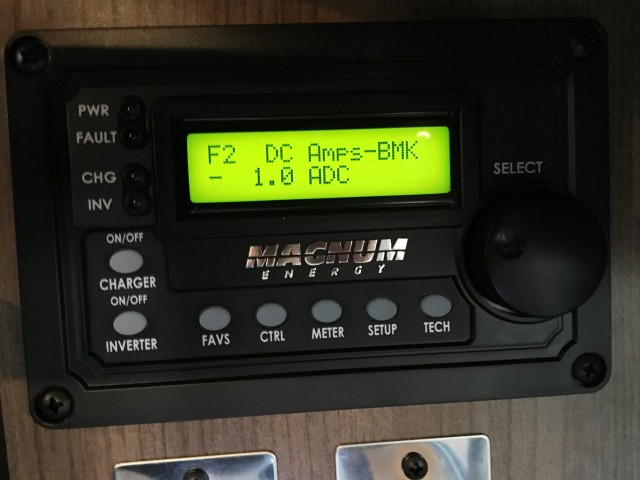
Here, it’s showing 1.0 amps going out of the batteries. The numbers go positive when I’m charging.
Since we’re running our Travato with the two stock AGM batteries, this information is pretty valuable. We have 200 amp-hours to work with, but you should really only use half of that. So the information from the BMK lets us answer that old question “How long could I run this on battery power?” very precisely. Where we have the same electrical appliances or fixtures that you do, these loads should be the same in your coach. But obviously, this is going to be the most accurate for other Travato owners.
Determining the Loads
The procedure for determining the various loads is pretty simple:
- Take a reading of amps in/out.
- Turn on the load in question.
- Take another reading.
- Subtract!
That’s it. I resorted to a number of methods for turning loads on and off. For something simple, like a light, I would just use the switch. But for something like the entertainment system, I would pull a fuse.
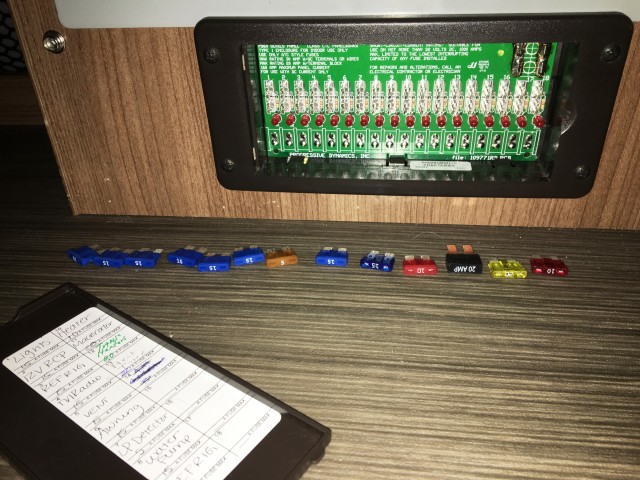
Before I could take the readings, I needed to disconnect the solar panels on Lance’s roof. The variable output from the solar panels would have made it impossible to get an accurate or repeatable reading. Fortunately, the Winnebago solar option has pluggable solar panels and a 3 port box on the roof, so this was really easy.
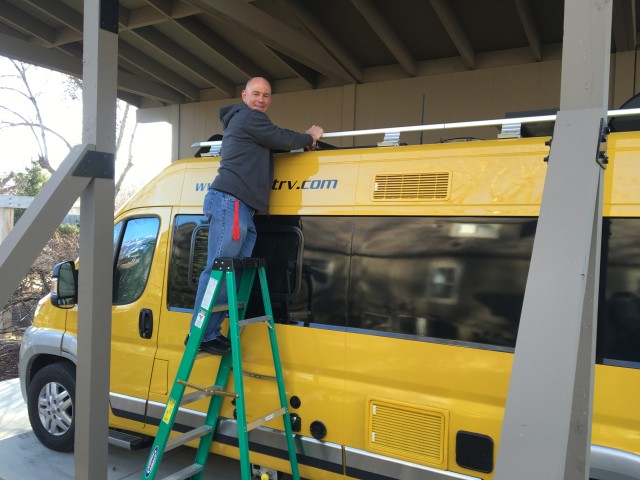
Probably wouldn’t have been much solar generated under the carport, but I like to go the extra mile…
So, without any further ado, here are the loads I found. Except where I’ve indicated, they’re not additive.
| Load | Amps |
|---|---|
| Background load, with coach battery disconnected. For me, this is the Auto Generator Start, and the display for the Battery Monitor Kit itself. | 0.2 A |
| Enabling Coach Battery (with all other fuses pulled) | Undetectable |
| Propane Leak Detector | 0.2 A |
| Other Background Loads (Vampire loads for Jensen, Truma, LEDs on USB outlets, etc.) | 0.2 A |
| Truma Control Panel (backlight on) | Undetectable |
| Jensen JWM 990 - Radio ON. Volume 25/40 | 1.0 A |
| TV Switch On | Undetectable |
| TV on (local station) | 1.4 A |
| DVD playing through TV Jensen at Volume 40/40 (A Fist Full of Dollars) | 2.4 A |
| External speakers – Full Volume (Peg, by Steely Dan) | 1.6 A |
| Truma Fan – Vent 2 | 0.4 A |
| Truma Fan – Vent 10 | 3.4 A |
| LED tube/strip Light Over Cab Entry - Low setting | 0.2 A |
| LED tube/strip Light Over Cab Entry - High setting | 1.0 A |
| LED Puck Lights (each – though each switch runs two lights) | 0.1 A |
| LED Exterior light | 0.6 A |
| Propane Solenoid – Enabled | 1.0 A |
| Fresh Water Pump | 1.4 A |
| Shower Waste Water Pump | 1.6 A |
| Awning Motor - Extend | 1.2 A |
| Awning Motor - Retract | 2.6 A |
| Maxx Air Fan – lowest speed | Undetectable |
| Maxx Air Fan – Highest speed | 2.2 A |
| Refrigerator on 12v | 14.0 A |
| Fan for composting toilet (Most won't have this) | Undetectable |
| Inverter on (Standby – all 120V breakers off. Magnum MS 2000) | 1.6 A |
| Inverter on (Microwave clock, 120V phantom loads) | 2.0 A |
| Inverter on – Refrigerator on 120V – just out of curiosity (Total Load) | 19.6 A |
| OnePlace Monitor panel – awake, displaying meters | Undetectable |
| WeBoost Drive 4G-X Cell Signal Booster | 1.0 A |
| Tank heaters switched on (Grey, black, and macerator) | 9.0 A |
| Water Line Heat Tape (My install only) | 0.4 A |
| Circular Bathroom Fan – Running | 1.4 A |
| Refrigerator on Gas (Not including Propane Valve) | Undetectable |
| LED Running Board Lights | .8 A |
| Typical Dry-Camping “standby” (All fuses in. Propane valve open. Truma and Jensen powered but dark. Fridge running on Gas) Total Load. (I've subtracted my Magnum accessories.) | 1.4 A |
Things I Found Interesting
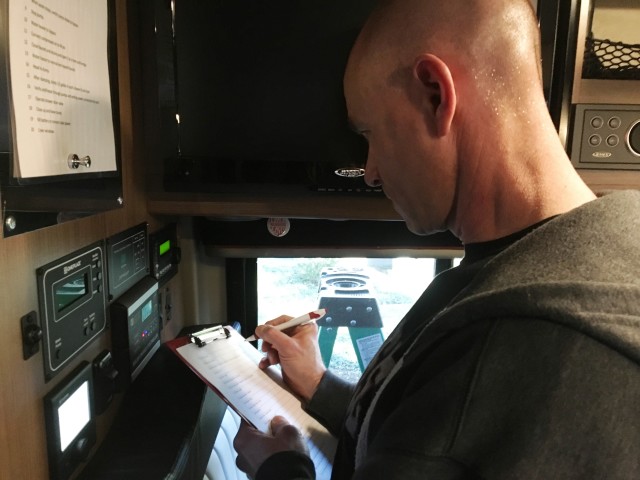
It takes one amp to keep the propane solenoid open. This means, to keep propane available in the coach all the time is costing me 24 amp-hours a day. That’s roughly one fourth of my usable battery capacity. Rather than leave it on all the time, it would make more sense to only have the propane valve open when I need it.
But I usually can’t… because we usually camp without hookups. When we do, we run the refrigerator on propane. While the propane fridge doesn’t use much electricity itself, another way to look at it is that the propane fridge requires 24 amp-hours a day to run, in addition to the propane.
And speaking of running the refrigerator on propane – you’re certainly going to want to do that! The 14 amp draw for the refrigerator was the biggest single 12 volt load I found. We’ll leave the fridge on 12v sometimes when we stop for lunch. (OK. Usually not on purpose. We usually forget.) Unless you’re going to be doing some more driving, you probably don’t want to leave it on 12v for very long unless you’re running the engine.
And just for grins, I ran the fridge on 120v off the inverter. I don’t know what I expected to see there, but I was just curious. The good news is that it with losses from the inverter and additional 120v phantom loads, it was more efficient to just run it on 12v. Good.
The LED tube light was sort of a surprise. The difference in draw between the low and high settings was 5 times – but the light certainly doesn’t seem 5 times brighter on high. So the lesson there is, if we’re really trying to stretch our battery life, use that light on “low”.
The results from the MaxxAir fan were kind of neat too. On the lowest speed, I couldn’t pick it up. This tells me that there’s very little energy cost to leaving it running for some ventilation while we’re out. Good to know.
And the Truma fan. Wow. Usually, it’s dead silent, and we never hear it. But if you turn it on “vent” and crank it up all the way… WOW! I didn’t know it could spin up that much! I don’t know if it was moving more air than the Maxx Air fan, but it was certainly using more Amps. But like I said, in actual use, the fan never runs that hard.
The good news from all of this – for us, anyway – is that with 300 watts of solar power on the roof, most of the minor loads are a wash. On a sunny day, we really don’t think much about our battery state of charge. And considering we drive most days, the alternator keeps us topped off, and it’s all pretty academic anyway. Still I found it interesting to go through the exercise. Hopefully, there’s something here you can use.
Cheers!


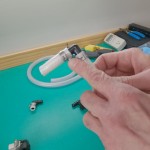








Did you happen have a reading Carefree awning Bluetooth phantom load (BT seems to be on 24/7)?
That RV had a Fiamma awning with no Bluetooth.
Our EKKO now – we ordered it without any awnings.
James— Love your blog.
I have a 2018 ERA 170A with two 100 watt solar panels, two AGM batteries and the Dometic 8330 fridge. I have a manual propane valve. Per your testing, the fridge on 12v will draw 14 amps per hour. This closely matches the theoretical amps per the manufacturer: 170 W/12v = 14.17 amps. So you need around 340 amps per day to run the fridge. The batteries will provide 100-160 amps and the 200W of solar in my latitude during the summer will provide an average of 68 amps/day, Assuming my calculations are correct, I should only be able to safely run the fridge for 12 hours on 12 volt.
The Dometic 8330 manual states that the fridge running on propane uses an average of 13.4 oz of propane per day at 77°. That means that you should be able to run the fridge for 9.5 days on one gallon of propane. The ERA 170A has a 16 gallon tank which can only be filled to 80% or 12.8 gallons. That’s over 4 months of fridge use! I find that very hard to believe.
What did you observe on your Travato before you replaced the fridge? How long were you able to run the fridge in 12 volt versus propane?
We only ran the fridge on 12 volt while driving, as it is a pretty big draw.
On propane, yes, the fridge will run for a long long time. It just sips the propane.
Of course, it’s an absorbtion fridge. We don’t like those. I’d replace it just on principle.
So I’m curious, what do you think the ideal fridge is if you’re frequently boondocking? I have the stock Nova Kool and while it does draw quite a bit of juice, I’ve just had to run my generator some between campgrounds where I’ll flush tanks, fill water, and plug in if available. Would like to be the least dependent as possible though.
I’ll never go back to an absorption (propane-powered) fridge. That’s not a fridge at all. It’s a cooler. And a poor one at that.
12v fridge and adequate solar panels and battery power to keep it running. That’s all we’ve ever needed.
James,
We have a 2018 Pleasure Way Ascent on order with the 190 watt solar package, $1560 option & max for the 19 ft van. Since it will be stored inside and we rarely boondock I beginning to think that any solar is just a waste of money and also another maintence item that provides almost no benefit. Am I missing something or should I just omit the solar option?
If you rarely boondock, and if the rig is stored inside… I’m having trouble seeing how solar energy will benefit you much.
If you’re plugged in, the solar power would be pretty much pointless.
I know your battery system isn’t close to stock anymore, but could you comment on where you put the shunt for the BMS in early 2016 when your batteries were mounted in the original location under the coach? Is it OK to put the shunt under the van where it could get wet? Where did you mount it? The BMS installation descriptions I’ve found so far show their shunts neatly mounted on the wall of a battery compartment, which the Travato batteries sure don’t have. I know it’s important to have a BMS, but I can’t figure how to locate the shunt. Thank you!
Hi Sally – The shunt should be mounted near to the battery. When we did the early 2016 install, the folks at AM Solar mounted the shunt underneath the vehicle. So yes, it could get wet, dirty, etc. It’s on the negative side of things, so there’s not much danger from doing that. I suppose, hypothetically, if it was wet enough that the shunt grounded out, that could be a problem. But then the vehicle would be so wet that I’d have other, bigger issues. If I were installing one today on your rig, I’d mount it underneath and not worry about it too much. If you’re still not satisfied, you could check a marine supply outlet and see if they have one that’s got a covering of some sort?
It’s so helpful to know the shunt worked for you under the van. Thanks again for all the fun and info you guys share.
I’ve been pondering the solar options lately and I tend to think that “more is better¨ since we plan to be off grid often. I can get up to 4 panels with a total of 380 watts as a factory option on the RV I’m considering.
But your comment on car port shade got me thinking that in hot weather, I will try to find shade to park, since you can’t realistically use the A/C off grid. So the it get to be a compromise between a hotter RV or more power from the panels (another 8 step compromise LOL). What is the panel efficiency in typical outside ambiant lighting with no direct sunlight? I remember from your post on Winnebago Life that the Travato has a plug for optional remote panels that could be placed in the sun, but with class B space limitations, I don’t really want to bring along my portable panels.
Maybe that’s something you can measure with your system and give me some feedback if ever this interest you and you have time. Your car port is probably darker than the typical park under some trees situation.
That’s an interesting idea. Not sure how accurate it will be, but it’s easy enough to check.
I’ll be moving the RV out in a day or so, I’ll try to remember and reply back here.
300 Watts of Solar Panels.
Cloudy day.
Under carport – producing 0.0 amps.
Outside of carport – producing 3.1 amps.
So a cloudy day covers your basic dry camping “stand by” currant of 1,4A with a little trickle charge left over for the battery. Not much but at least it’s got you covered while you’re out doing activities.
Really appreciate this post James; it’s very useful! Please keep the electrical mod details coming.
AM Solar (busy guys) are going to heavily upgrade our Trend this July, so knowing your Travato’s loads is a huge help.
Any chance you know how many Amps your alternator is putting into the batteries?
Glad you found it helpful.
As far as the amps from the alternator, it varies depending on how depleted the batteries are. If they are drained pretty well, then the alternator will throw a lot of amps at them initially. I’ve seen upwards of 80. As they charge, the current decreases. The wiring from Winnebago was completely adequate in our case. Don’t know what you’re having done, but they guys at AM Solar have the big stuff there on hand if they figure you need it.
Good luck with the upgrades!
Good to hear. The Trend comes with the 220 alternator, so we might see more than that although we’ll be heavier than Lance, so maybe not.
We’re still in the planning stages and assuming we can find space for everything, they’ll be adding lithium (we need the weight savings), panels, that slick BMK, and an inverter/charger. I’d really like to run the MH’s AC while we’re driving too (without worrying about constant genny oil changes), but that might not be practical.
Our appointment is for July and this June we’ll be in Salt Lake City again for a conference, so we might return resolved to make it practical. If not for us, then for the kids and dog baking in the back.
I really think you COULD run the AC while driving. As soon as it’s warm enough that I can get our compressor to kick on, I’m going to try it. Look back here for that!
From living on a sailboat over several winters we got in the habit of turning off the propane switch when not in use. Continued with that in our Travato 59K. Didn’t realize that it used 24 amp hours though. Another reason to be glad we have the Novakool compressor frig.
Question, is the Magnum BMK part of the auto gen start? In other words, is it connected directly to the Onan?
The Magnum BMK, Auto Gen Start (AGS), Inverter, and Control Panel are all purchased separately. Only the AGS module itself is actually connected to the Onan.
All of the Magnum modules are connected to each other on a network of 4-conductor phone wires.
If the RV manufacturers were serious about designing RVs that could live off the grid, they would figure out the answer to a 1 A propane valve that gobbles up a huge amount of battery reserves. It’s just like making appliances green. You need to put some effort in it. I have the same 1 A valve dilemma. It hasn’t affected me as I had solar panels and sunny days or had daily driving like you but it could if I experienced cloudy days.
In some ways, they’re restricted in their design options by RVIA safety codes. There has to be a fail-safe way to close the propane tank, and it has to be accessible from outside the vehicle. So when the tank is mounted away from the sides, they have to use a remote solenoid. Since it has to be fail-safe (it has to fail in the “closed” position, even if the batteries became disconnected), they have to use a normally closed solenoid – which means it requires current to keep it open. Is there a normally closed, solenoid-actuated valve that is rated for propane, with a high enough flow rate, that requires less than 1A to keep open? I don’t know.
Beyond that, the only real fix is relocating the propane tank.
Our refrigerator is kicking on and switching off many times during the day. When I take a reading I have no idea how many hours a day it is in that state. Does your refrigerator stay on constantly? If not, you might be using less electricity than you calculate. How can I get a handle on how much our frig really uses?
Our refrigerator is a Dometic RML-8330. The numbers are valid for that.
On 12v, the refrigerator stays on constantly – in addition to needing to keep the propane solenoid open.
You don’t mention what fridge you have, but if it cycles on and off – and you can hear it – it’s likely a compressor fridge.
As you point out, you’d need to know the ratio of how much it is on or off to calculate a full day’s amp-hour load for it.
If it’s a residential -style refrigerator, you could always plug it into a Kill-a-Watt (one of my favorite gadgets!) to determine the watt-hour usage for a day. The Kill-a-Watt is fun to use in any case.
Nice set up! Same Magnum hardware we have in our off-grid home. The BMK is a must have 🙂 and also expands utility of the system, allowing you to use different set point parameters – like SOC – should a person wish, to auto start and stop the gen.
SOC is what I trigger the auto gen start with. 🙂
Why do I picture you on your back as Ken Mattingly calmly talking a Travato owner with a crippled power system orbiting Houston through a complex power up procedure?
Well now THERE’S an interesting reference!
Great post. I did the same tests on our last RV (2005 Chinook Concourse ) using a multimeter. The propane solenoid had the same draw you found here. I also found that the LP detector had more draw than I would have expected (.4). On our 2008 Winnebago View, the propane is a standard valve rather than A solinoid. Saving those 24 amp hours is nice.
For the manufacturer, I think that decision comes down to where they have to locate the propane tank. You get a regular valve if they can locate it near the outside edges. That’s my take…